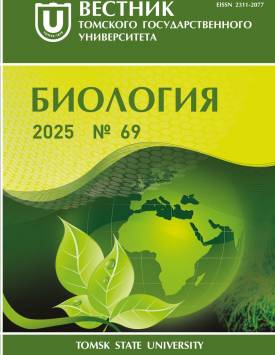Genetic landscape of the Altai peoples by Y-chromosome haplogroups
The Altaians are a Turkic-speaking people who mainly live in the Altai Republic. They are divided into several ethnic groups. The number of northern Altaians is much smaller than the southern ones. Significant differences have been shown between them according to anthropological and linguistic data. The northern Altaians have the most pronounced shift towards the Uralians. They were formed as a result of the interaction of ancient Samoyedic, Ket, Ugric and Turkic tribes. The southern Altaians were formed due to the mixing of Turkic and Mongolian tribes. The material for the study was DNA samples of men belonging to different ethnic groups of the Altaians. The total sample of northern Altaian men was 139 people: Tubalars (N = 99), Chelkans (N = 27), Kumandins (N = 13). The sample of southern Altaians males consisted of 434 people: Telengits (N = 99) and Altai-Kizhi (N = 335). Using 386 SNP markers, the belonging to Y-chromosome haplogroups was determined. Analysis of STR haplotypes within haplogroups was carried out using 44 YSTRs (DYS19, 385a, 385b, 388, 389I, 389II, 390, 391, 392, 393, 426, 434, 435, 437, 438, 439, 442, 444, 445, 448, 449, 456, 458, 460, 461,481, 504, 505, 518, 525, 531, 533, 537, 552, 570, 576, 635, 643, YCAIIa, YCAIIb, GATA H4.1, Y-GATA-A10, GGAAT1B07). The samples of northern and southern Altaians differ significantly in the composition and frequencies of Y-chromosome haplogroups. Haplogroup R1a1a1b2e1~ (YP1509) is completely dominant among Tubalars. Individual samples of Kumandins and Chelkans belonging to this haplogroup differ in haplotypes from Tubalars. This sublineage does not demonstrate a recent founder effect and a significant increase in the number of descendants of a common male ancestor over the past hundreds of years according to YSTR haplotypes. Some samples of Tubalars, Kumandins and Chelkans belong to the related haplogroup R1a1a1b2a2a3~ (Y42090). Among Tubalars, its frequency is 22%. These two haplogroups (R1a1a1b2e1~ and R1a1a1b2a2a3~) are the heritage of the Turkic peoples. Haplogroup Q1b1a1a1g~ (YP3951) is dominant in the Chelkans (63%) and forms a starshaped phylogeny with a recent founder effect in the male line. Its two branches in the Chelkans, Kumandins and Tubalars are associated with the descendants of the local population of this region related to the peoples belonging to the Yeniseian language family. The Kumandins have the highest frequency of the R1b1a1a1a (M478) lineage, which was found in only one Altai-Kizhi man. The haplogroup R1a1a1 (YP1518) is dominant in frequency in the Telengits (58%), which is present with a very low frequency in the Altai-Kizhi. The dominance of this haplogroup is associated with the legacy of the ancient Turkic-speaking Tele tribes, who were not included in the Northern Altaians and Altai-Kizhi. The second most frequent (10%) haplogroup is N1a1a1a1a3a2 (B219), which is dominant among the eastern Buryats and is present among the Mongols and Tuvans. They also have haplogroup N1a2b1b1 (B478), which is inherited from the local Samoyed population, with a frequency of 6%. Their population samples from different villages differ in haplogroup frequency. The Altai-Kizhi are dominated by haplogroup R1a1a1b2a2a3b1a1~ (YP1542) (30%). Three more of their haplogroups are predominant in the descendants of the early population of modem Mongolia - C2a1a2a2a (Y12825), C2a1a3a1c (Y12782), C2b1a1a1a1, N1a1a1a1a3a2 (B219) are present in many villages where the Altai-Kizhi live. Eighteen men from various villages belong to haplogroup Q1b1a3b1a (YP1693), which occupies 13% of the total sample of Tuvans. The southern Altaians have haplogroups D (15 samples) and J2b2b2 (Y18042) (18 samples). Nineteen men belong to the Samoyedic haplogroup N1a2b1b1 (B478), which makes up a small frequency in samples from different regions. Haplogroup J2b2b2 (Y18042) is associated with people from the territory of modern Iran and the Middle East. In this research we revealed that the most frequent sublineages of the Y chromosome among samples of the indigenous population of the Altai Mountains are variants of haplogroup R1a1, which are associated with various Turkic tribes that settled these territories and mixed with the local aboriginal population. They do not demonstrate a recent founder effect and significant demographic growth of these populations. A detailed study of the gene pool of all northern and southern Altaians by Y-chromosome haplogroups was conducted. The maximum multicomponent composition of the gene pool was found in the Altai-Kizhi. The Chelkans showed a founder effect in the male line over the past hundreds of years. Kumandins, Chelkans, Tubalars, Telengits and Altai-Kizhi are characterized by a specific composition and frequencies of haplogroups, the presence of which is associated with different ancestral groups of populations. The paper contains 2 Figures, 9 References. The Authors declare no conflict of interest.
Keywords
gene pool of the Altai people, ehnogenesise, Y-chromosomeAuthors
| Name | Organization | |
| Kharkov Vladimir N. | Research Institute of Medical Genetics, Tomsk National Medical Research Center | vladimir-kharkov@medgenetics.ru |
| Valikhova Larisa V. | Research Institute of Medical Genetics, Tomsk National Medical Research Center | larisa_ermizova9@mail.ru |
| Luzina Faina A. | Research Institute for Complex Problems of Hygiene and Occupational Diseases | luzina45@mail.ru |
| Stepanov Vadim A. | Research Institute of Medical Genetics, Tomsk National Medical Research Center | vadim-stepanov@medgenetics.ru |
References

Genetic landscape of the Altai peoples by Y-chromosome haplogroups | Vestnik Tomskogo gosudarstvennogo universiteta. Biologiya - Tomsk State University Journal of Biology. 2025. № 69. DOI: 10.17223/19988591/69/19
